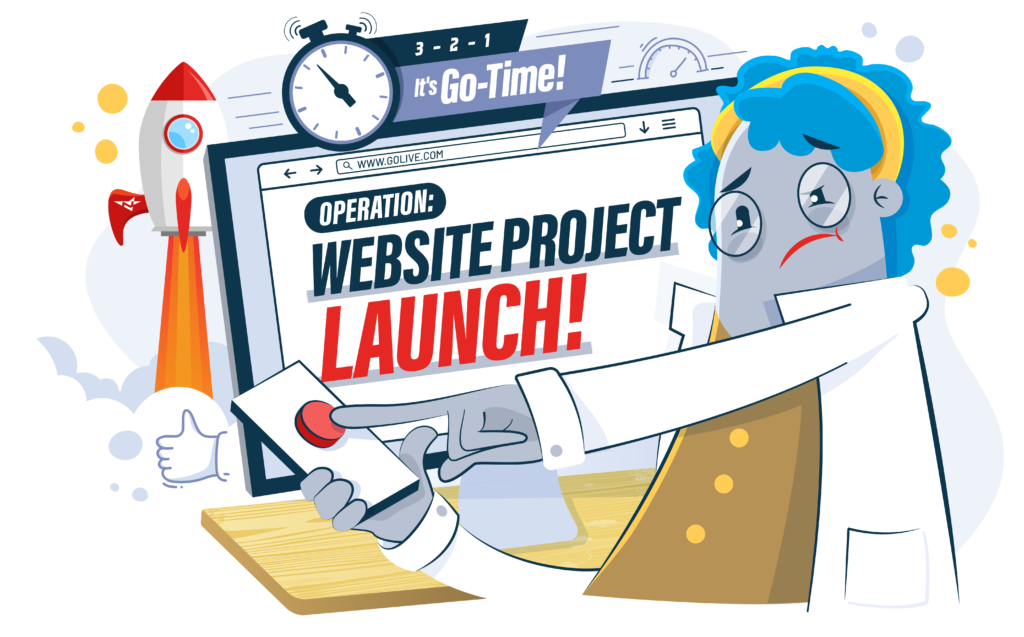
It’s Been a While...
At last, the board has approved the budget and given you the green light. It’s go-time. Finally, your school is getting a new website!
You thank them, assure them it’s going to be a smashing success, then step out of the conference room, gently closing the door behind you. You spin around, pump your fist, and let out a silent “whoop!” of excitement. Your team is waiting, and they can tell by your happy dance that you’ve got good news! As you round the corner out of earshot of the board room, they hoist you into the air and carry you down the hall, singing anthems of praise in your honor. You land on your feet, high-fives all around. Someone pops a cork (it must be after hours).
Then you step into your office, close the door … and have a good cry. First, tears of joy — then tears of terror.
With everything else you’ve got in motion right now, how are you going to pull this off?
It’s been several years since your last major website overhaul. The key players who worked on that project are either long gone or are up to their eyeballs in other commitments. It’s on you (and your crew of thrillseekers) to make this project a success.
And it’s got to be good. No, not just good. Your cross-town rivals have “good websites.” Your school’s website has to be GREAT. The one that floats to the top of Google’s search results, greets new families like old friends, makes them feel at home, serves up exactly what they need (but not too much), and welcomes their request for an on-campus tour. Is that really too much to ask?
Thinking Ahead
Perhaps you’ve been there. Or maybe this scenario is on the horizon for you and your team. There’s the thrill of the prospect of a new website, and then there’s the reality of the work it will take to pull it off.
I get it — your team is busy. And the key internal stakeholders you need to make it happen are in-demand. Even with a qualified agency partner to do a lot of the heavy lifting, it’s going to be a big project. How can you get out in front of this thing to help it go smoothly?
In “The Art of War,” an ancient classic that has won the hearts and minds of modern-day business strategists, Sun Tzu writes, “Every battle is won or lost before it is ever fought.”
While I can’t vouch for Sun’s advice on the battlefield, I can assure you that in the context of school website development, truer words have never been spoken. The key to a successful website project is to get out in front of it with some deliberate pre-planning. This is the thinking and organizing you can do ahead of time to make the build go smoothly.
Here are some pointers to get you off to a good start before your school’s website project is officially underway:
1.
Setup a project team
Before you officially kick off the website build, identify a project team to walk the Marketing Director (or project lead) through the entire process. Let’s be clear, this is not a committee. This is a task force — a small team of three to five people who get along, believe in the project, know the school well, and bring specific skill sets to the table. Once you’ve identified your team, set a cadence for meetings, clarify roles and responsibilities, and define a core set of objectives for the project.
2.
Clearly articulate the objectives for your school’s website build
I can’t overstate the importance of this collaborative exercise. You need to have a shared understanding of what you’re aiming to accomplish through this project. Capture the obvious ones quickly (i.e., freshen up the design, update the photography, remove outdated content, etc.) and then move on to more significant gains. These could include making the prospective parent the primary audience, increasing qualified leads, building in calls-to-action (CTAs) at key inflection points, integrating Age-and-Stage® pathways, etc. Don’t overthink it. Keep it simple. Develop a list of 6-10 meaningful objectives that, if realized, will make a big difference for your school. Once you’ve got your list, be sure to lead with these objectives when discussing your website project with potential agency partners. They need to understand your aims so you can have a shared vision of success.
3.
Spread the word and ask for feedback
When it’s a sure thing that you’re going to move forward with a new website, notify your faculty and staff, and put them on notice that they may be asked to pitch in. Set the tone by reinforcing the value of the investment. They need to see the website as a major factor in how students end up in their classrooms. You may also find it helpful to gather feedback from current families, being particularly mindful of areas of the site they find confusing or unhelpful. Pay close attention to families who came to your school within the past year; Ask them about their experience on your website before they made their decision to enroll.
4.
Give team members time and space to do the project well
Your project team members will need to offload some responsibilities and pause some other initiatives to make sure the website initiative is done well and in a timely manner. In fact, some team members will need to have the latitude to dedicate full days of focused concentration during the planning and content phases. These activities are too important to the overall success of the project to fit in around the edges of other projects. Commit ahead of time to carve out time on a regular basis for your key contributors; in the early stages of the build, you will likely need to give the project at least one full day per week.
5.
Get a head start on your content plan
The highest hurdle in most website projects is not the design or tech, but rather the content. Again, team members simply aren’t in the habit of writing extensively for the website. Sure, they may contribute regularly to your blog, news sections, calendars, and media galleries, but deconstructing and rebuilding your website’s sitemap is not part of their daily rhythms. We call this the KRN process — Keep, Revise, New. And it’s time-consuming and a bit tedious. But you can’t do a comprehensive overhaul without stepping through some form of this exercise. It takes deep focus with bursts of collaboration.
Our best advice here? Don’t procrastinate. Identify an owner for this part of the project, and get them started early. Map your ideal sitemap for your new site, and get started. (By the way, your agency should give you some guidance here, so you shouldn’t have to figure out this process on your own.) To get content team members moving, reinforce the significance of their contributions to the project and give them clear instructions on how to contribute. Set deadlines and communicate early and often in order to identify and address bottlenecks.
6.
Involve outside vendors into regular status update conversations
If you’re engaging an outside firm to help you with the development of the site, start the conversation by providing a written list of your objectives for the website project (see Step 2). This will move the conversation forward faster and with more clarity. Be sure to communicate that you want them to schedule regular planning and status meetings between your internal point person and your project lead at the firm. They should keep you focused on what’s next in the process and what the required inputs will be from your team for each phase.
7.
Build improvement into your plan moving forward
Most schools will have far more on their website wishlist than what their budget will permit. If this is the case for your team, don’t be discouraged. That’s what a backlog is for. A backlog is simply a prioritized list of initiatives that you work through as time and budget allow. Ideally, you’re making some progress each month. This approach is becoming increasingly common in the business world, and we believe that schools should embrace the model as well. Making consistent progress through a backlog of website improvements prolongs the life of your website and, if prioritized effectively, can significantly increase your lead generation. At North Star Marketing we refer to this backlog-oriented approach as “Growth-driven Development.”
An ounce of prevention is worth a pound of cure
While website projects are outside the norm for most schools, they don’t have to be long, drawn-out, frustrating endeavors. The key is getting organized and aligned before the heavy lifting begins. Harness the energy and anticipation around your upcoming website project and get on the same page. And sometime in the not-too-distant future, your team will be celebrating again when your shiny website goes live.

